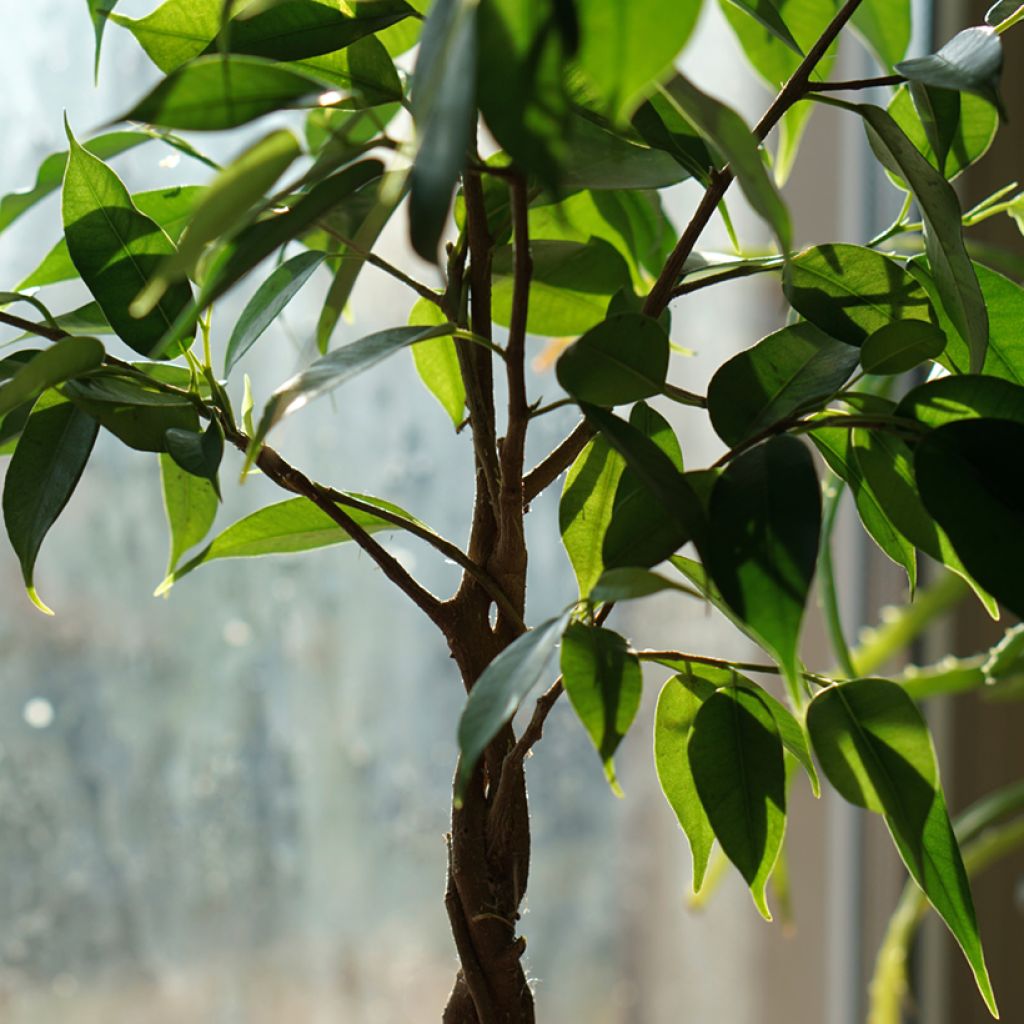

Ficus benjamina Natasja - Weeping fig


Ficus benjamina Natasja - Weeping fig


Ficus benjamina Natasja - Weeping fig
Ficus benjamina Natasja - Weeping fig
Ficus benjamina Natasja
Indoor plant fig, weeping fig
Special offer!
Receive a €20 voucher for any order over €90 (excluding delivery costs, credit notes, and plastic-free options)!
1- Add your favorite plants to your cart.
2- Once you have reached €90, confirm your order (you can even choose the delivery date!).
3- As soon as your order is shipped, you will receive an email containing your voucher code, valid for 3 months (90 days).
Your voucher is unique and can only be used once, for any order with a minimum value of €20, excluding delivery costs.
Can be combined with other current offers, non-divisible and non-refundable.
Home or relay delivery (depending on size and destination)
Schedule delivery date,
and select date in basket
This plant carries a 30 days recovery warranty
More information
We guarantee the quality of our plants for a full growing cycle, and will replace at our expense any plant that fails to recover under normal climatic and planting conditions.
Description
The Ficus benjamina 'Natasja' is commonly known as the Dwarf Weeping Fig (or Ficus 'Natasja' Houseplant) due to its moderate growth, making it well-suited to small spaces. It forms a beautiful, upright and spreading clump with an evergreen foliage of a uniform glossy green, except at the tips where young leaves emerge in lighter green tones. This plant is well-adapted to contemporary or Scandinavian décors while adding an exotic and tropical touch even in compact spaces. Place it in a bright spot away from direct sunlight and keep the compost slightly moist.
The Ficus belongs to the Moraceae botanical family which includes around forty genera from both tropical regions and temperate climates, encompassing fruit trees like the Mediterranean Fig Tree, or ornamental plants such as the Osage Orange (Maclura pomifera). The Ficus genus comprises approximately 750 mostly tropical species including the Ficus benjamina, native to a vast region stretching from Asia to the Pacific Islands and northern Australia. In the wild, it grows at altitudes between 400 and 800 metres in humid mixed forests (comprising diverse species). This tree can reach heights of 20 metres and spread even wider, up to 60 metres in span, supported by massive aerial roots that reach the ground and act as props to stabilise its branches! Tolerant of light frosts, beautiful specimens can be admired in mild Mediterranean climates and the Canary Islands.
The 'Natasja' cultivar has a much more modest growth, rarely exceeding 1.50 metres in height and typically staying around 1.20 metres tall with a spread of 50 to 60 cm. It forms a dense clump with several main woody stems growing almost vertically, with an attractive brown bark. These are adorned with fine, slightly laterally spreading herbaceous green branches at their tips. Despite its 'Weeping Fig' name, its overall habit is rather upright but not rigid, as the leaves have a slight droop, and its silhouette somewhat resembling that of a Birch tree. Carried on short petioles, the leaves are elliptical with tapered tips. Often curved rather than flat, they also form a slight V-shape along the central vein. They measure 5 to 8 cm long. Their deep green surface is glossy, even shiny, enhancing the plant's ornamental appeal. When emerging, young leaves are a lighter green, creating a subtle yet harmonious contrast. Beyond its decorative qualities, the foliage is reputed to effectively filter toxins such as formaldehyde and xylene. This air-purifying plant adapts to a fairly wide temperature range, from 15°C in winter to 24°C in summer, and thrives in bright but indirect light. Generally easy to grow and low-maintenance, it dislikes stress factors like draughts, underwatering, or even relocation, which may cause leaves to drop. Fortunately, it usually recovers well.
The Ficus benjamina Natasja is ideal for small spaces where the standard species often become too bulky after a few years. It fits seamlessly into both modern and traditional interiors. To create a 'jungle-inspired' display, pair it with a pot of Spider Plant with variegated leaves for added colour, letting its numerous aerial shoots cascade freely. Add further vibrancy with a variety of Aglaonema featuring a foliage speckled with pink or red, creating an attractive year-round display.
Report an error about the product description
Foliage
Plant habit
Botanical data
Ficus
benjamina
Natasja
Moraceae
Indoor plant fig, weeping fig
Cultivar or hybrid
Safety measures
Other Ficus - Indoor plant fig
View all →Location
Location
Maintenance and care
Watering tips
Potting advice, substrates and fertilisers
Houseplant care
Disease and pest advice
Maintenance and care
This item has not been reviewed yet - be the first to leave a review about it.
Haven't found what you were looking for?
Hardiness is the lowest winter temperature a plant can endure without suffering serious damage or even dying. However, hardiness is affected by location (a sheltered area, such as a patio), protection (winter cover) and soil type (hardiness is improved by well-drained soil).

Photo Sharing Terms & Conditions
In order to encourage gardeners to interact and share their experiences, Promesse de fleurs offers various media enabling content to be uploaded onto its Site - in particular via the ‘Photo sharing’ module.
The User agrees to refrain from:
- Posting any content that is illegal, prejudicial, insulting, racist, inciteful to hatred, revisionist, contrary to public decency, that infringes on privacy or on the privacy rights of third parties, in particular the publicity rights of persons and goods, intellectual property rights, or the right to privacy.
- Submitting content on behalf of a third party;
- Impersonate the identity of a third party and/or publish any personal information about a third party;
In general, the User undertakes to refrain from any unethical behaviour.
All Content (in particular text, comments, files, images, photos, videos, creative works, etc.), which may be subject to property or intellectual property rights, image or other private rights, shall remain the property of the User, subject to the limited rights granted by the terms of the licence granted by Promesse de fleurs as stated below. Users are at liberty to publish or not to publish such Content on the Site, notably via the ‘Photo Sharing’ facility, and accept that this Content shall be made public and freely accessible, notably on the Internet.
Users further acknowledge, undertake to have ,and guarantee that they hold all necessary rights and permissions to publish such material on the Site, in particular with regard to the legislation in force pertaining to any privacy, property, intellectual property, image, or contractual rights, or rights of any other nature. By publishing such Content on the Site, Users acknowledge accepting full liability as publishers of the Content within the meaning of the law, and grant Promesse de fleurs, free of charge, an inclusive, worldwide licence for the said Content for the entire duration of its publication, including all reproduction, representation, up/downloading, displaying, performing, transmission, and storage rights.
Users also grant permission for their name to be linked to the Content and accept that this link may not always be made available.
By engaging in posting material, Users consent to their Content becoming automatically accessible on the Internet, in particular on other sites and/or blogs and/or web pages of the Promesse de fleurs site, including in particular social pages and the Promesse de fleurs catalogue.
Users may secure the removal of entrusted content free of charge by issuing a simple request via our contact form.
The flowering period indicated on our website applies to countries and regions located in USDA zone 8 (France, the United Kingdom, Ireland, the Netherlands, etc.)
It will vary according to where you live:
- In zones 9 to 10 (Italy, Spain, Greece, etc.), flowering will occur about 2 to 4 weeks earlier.
- In zones 6 to 7 (Germany, Poland, Slovenia, and lower mountainous regions), flowering will be delayed by 2 to 3 weeks.
- In zone 5 (Central Europe, Scandinavia), blooming will be delayed by 3 to 5 weeks.
In temperate climates, pruning of spring-flowering shrubs (forsythia, spireas, etc.) should be done just after flowering.
Pruning of summer-flowering shrubs (Indian Lilac, Perovskia, etc.) can be done in winter or spring.
In cold regions as well as with frost-sensitive plants, avoid pruning too early when severe frosts may still occur.
The planting period indicated on our website applies to countries and regions located in USDA zone 8 (France, United Kingdom, Ireland, Netherlands).
It will vary according to where you live:
- In Mediterranean zones (Marseille, Madrid, Milan, etc.), autumn and winter are the best planting periods.
- In continental zones (Strasbourg, Munich, Vienna, etc.), delay planting by 2 to 3 weeks in spring and bring it forward by 2 to 4 weeks in autumn.
- In mountainous regions (the Alps, Pyrenees, Carpathians, etc.), it is best to plant in late spring (May-June) or late summer (August-September).
The harvesting period indicated on our website applies to countries and regions in USDA zone 8 (France, England, Ireland, the Netherlands).
In colder areas (Scandinavia, Poland, Austria...) fruit and vegetable harvests are likely to be delayed by 3-4 weeks.
In warmer areas (Italy, Spain, Greece, etc.), harvesting will probably take place earlier, depending on weather conditions.
The sowing periods indicated on our website apply to countries and regions within USDA Zone 8 (France, UK, Ireland, Netherlands).
In colder areas (Scandinavia, Poland, Austria...), delay any outdoor sowing by 3-4 weeks, or sow under glass.
In warmer climes (Italy, Spain, Greece, etc.), bring outdoor sowing forward by a few weeks.































